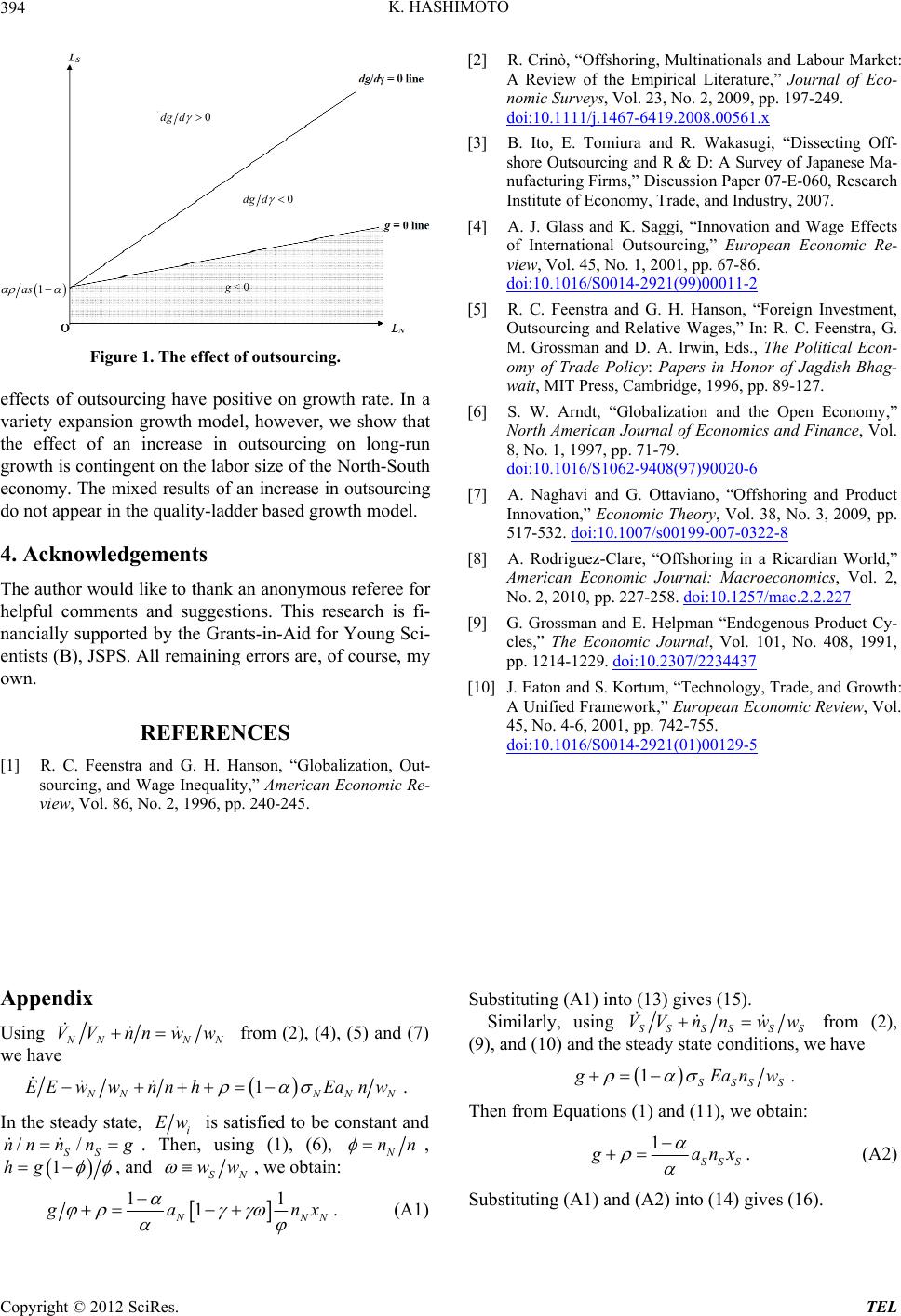
K. HASHIMOTO
Copyright © 2012 SciRes. TEL
394
[2] R. Crinò, “Offshoring, Multinationals and Labour Market:
A Review of the Empirical Literature,” Journal of Eco-
nomic Surveys, Vol. 23, No. 2, 2009, pp. 197-249.
doi:10.1111/j.1467-6419.2008.00561.x
0dgd
1as
0dg d
0dg d
[3] B. Ito, E. Tomiura and R. Wakasugi, “Dissecting Off-
shore Outsourcing and R & D: A Survey of Japanese Ma-
nufacturing Firms,” Discussion Paper 07-E-060, Research
Institute of Economy, Trade, and Industry, 2007.
[4] A. J. Glass and K. Saggi, “Innovation and Wage Effects
of International Outsourcing,” European Economic Re-
view, Vol. 45, No. 1, 2001, pp. 67-86.
doi:10.1016/S0014-2921(99)00011-2
[5] R. C. Feenstra and G. H. Hanson, “Foreign Investment,
Outsourcing and Relative Wages,” In: R. C. Feenstra, G.
M. Grossman and D. A. Irwin, Eds., The Political Econ-
omy of Trade Policy: Papers in Honor of Jagdish Bhag-
wait, MIT Press, Cambridge, 1996, pp. 89-127.
Figure 1. The effect of outsourcing.
ffects of outsourcing have positive on growth rate.
4. Acknowledgements
k an anonymous referee for
REFERENCES
[1] R. C. Feenstrlobalization, Out-
eIn a [6] S. W. Arndt, “Globalization and the Open Economy,”
North American Journal of Economics and Finance, Vol.
8, No. 1, 1997, pp. 71-79.
doi:10.1016/S1062-9408(97)90020-6
variety expansion growth model, however, we show that
the effect of an increase in outsourcing on long-run
growth is contingent on the labor size of the North-South
economy. The mixed results of an increase in outsourcing
do not appear in the quality-ladder based growth model. [7] A. Naghavi and G. Ottaviano, “Offshoring and Product
Innovation,” Economic Theory, Vol. 38, No. 3, 2009, pp.
517-532. doi:10.1007/s00199-007-0322-8
[8] A. Rodriguez-Clare, “Offshoring in a Ricardian World,”
American Economic Journal: Macroeconomics, Vol. 2,
No. 2, 2010, pp. 227-258. doi:10.1257/mac.2.2.227
The author would like to than
helpful comments and suggestions. This research is fi-
nancially supported by the Grants-in-Aid for Young Sci-
entists (B), JSPS. All remaining errors are, of course, my
own.
[9] G. Grossman and E. Helpman “Endogenous Product Cy-
cles,” The Economic Journal, Vol. 101, No. 408, 1991,
pp. 1214-1229. doi:10.2307/2234437
[10] J. Eaton and S. Kortum, “Technology, Trade, and Growth:
A Unified Framework,” European Economic Review, Vol.
45, No. 4-6, 2001, pp. 742-755.
doi:10.1016/S0014-2921(01)00129-5
a and G. H. Hanson, “G
sourcing, and Wage Inequality,” American Economic Re-
view, Vol. 86, No. 2, 1996, pp. 240-245.
Appendix
Using
NNN
nnww
from (2), (4), (5) and (7)
e
VV
we hav
1
NNNN
wwnnhEanw
.
In the steady state,
EE
i
Ew is satisfied to be constant
en
and
//
SS
nn nng
. Th, using (1), (6), N
nn
,
1hg
, and SN
ww
, we obtain:
11
1
NN
an
(A1)
Substituting (A1) into (13) gives (15).
x
.
SS SS
VV nnw
Similarly, using S S
w from (2),
(9tate conditions, w), and (10) and the steady se have
1SSSS
Ea nw
.
Then from Equations (1) and (11), we obtain:
1
SSS
anx
.
(A2)
Substituting (A1) and (A2) into (14) gives (16).